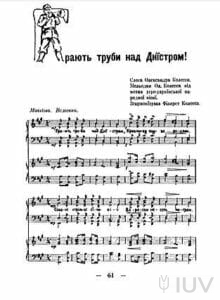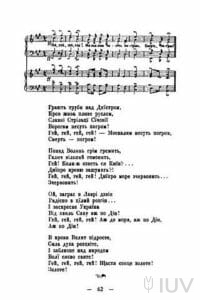Filaret Mykhailovych Kolessa (17.07.1871, Tatarske village, now Pishchany village, Stryi district, Lviv region – 3.03.1947, Lviv).
He was a full member of the T. Shevchenko Scientific Society, Member of Verkhovna Rada of the USSR (Ukrainian Socialist Soviet Republic) of the 2nd convocation.
He devoted his life to the development and preservation of Ukrainian folk art and music.

Family
Kolessa had two brothers, Oleksandr and Ivan Kolessa. He had three children: Mykola Kolessa, Daria Kolessa-Zaleska and Sofiia Kolessa-Sondei.
His elder brother, Ivan Kolessa, had a great influence on the musical and folklore interests of the young Filaret. Following the brother’s instruction, Kolessa actively collected folk art, arranged folk songs for choirs and vocal ensembles.
His vision of life was also strongly affected by his other brother, Oleksandr Kolessa, who was a literature critic, linguist and active social and political activist.
Biography
Filaret Kolessa was born on July 17, 1871 in the village of Tatarske (now the village of Pishchany, Stryi distict, Lviv region)
From 1878, he studied in the school in Stryi (now school nr 7). In those years, he was just starting out, but his family had already helped him define his path.

In 1891 – 1892 he studied at the University of Vienna.
After graduating from high school, during his time at the Vienna Theological Seminary, Filaret Kolessa deepened his musical education. During his year-long stay in Austria, he attended a series of lectures on harmony by the prominent Austrian composer Anton Bruckner at the University of Vienna. He also attended opera performances and concerts, which also greatly influenced him in the future.
But he still returned home and in 1896 graduated from Lviv University at the Faculty of Philosophy, it was during this time that he paid considerable attention to his composing journey. During these years, he published many arrangements of folk songs.
In 1918, he defended his dissertation at the University of Vienna and received a doctorate in philology. He devoted himself to studying the rhythms of Ukrainian folk songs from Galicia, Volyn and Lemkivshchyna more closely.
In October 1939, when Western Ukraine joined the USSR, he was elected as a member of the People’s Assembly of Western Ukraine.
From 1939 – Professor at Lviv University, from 1940 – director of the State Museum of Ethnography in Lviv, head of the Lviv Department of the Institute of Art History, Folklore and Ethnography of the Academy of Sciences of the USSR.
In 1947, he became a member of the Verkhovna Rada in Kyiv (5 Mykhailo Hrushevskoho St. 01008)
He was an active participant in the international congresses of folklorists, musicologists and philologists.
He died on March 3, 1946, at the age of 75 in Lviv. He was buried in the family grave on the field nr. 78 of the Lychakiv Cemetery (Lviv, 33 Mechnikova St.).
Composing activities
Filaret Kolessa’s compositional activities are mainly concentrated in the choral genre. Original choruses to the words of Taras Shevchenko, Yuriy Fedkovych, Osyp Makovei, Oleksandr Oles and other poets, as well as numerous arrangements of Ukrainian folk songs that were an integral part of the repertoire of Western Ukrainian choirs and gained wide recognition.
- Lyrics and music to the song “Грають труби над Дністром!” (eng. “Trumpets are playing iver the Dnister!”) by Oleksandr Kolessa from the 1916 Vienna edition. Harmonized by Filaret Kolessa.
In the summer of 1908, Filaret Kolessa made a folklore expedition to Naddniprianshchyna region in Ukraine, recording the repertoire of six folk performers in the Myrhorod region. The fundamental goal of the expedition was to publish the melodies of the traditional kobzar and lirnyk repertoire.
The result of Filaret Kolessa’s five-year-long work, all the recorded and transcribed material was published in two volumes (XIII and XIV) of «Мелодій українських народних дум» (eng. “Melodies of Ukrainan Folk Dumas”) in 1910 and 1913, respectively.
You can view and re-read it on the website of the electronic library “Українка” (eng. “Ukrainka”)
Kolessa divided the evolution of folklore into three periods:
- the ancient era (the heyday of knightly and squadron poetry, ritual sings with Christian plot elements)
- the Middle Ages – the golden age of Ukrainian folk poetry (Cossack historical songs and dumas, development of love lyrics)
- the modern era (new content is embodied in ancient forms, the rapid development of the short form)
It also proved the necessity of studying folklore by the fact that:
- Oral tradition is older than literature
- Folklore is a valuable material for understanding the worldview of our ancestors
- Oral literature is a source for written literature
- All methods of studying folklore are important for elucidating the genesis of poetic genres, because they highlight cultural interactions and the degree of their nationalization.
The most famous musical works of Filaret Kolessa
- Chorus «Ой умер старий батько» (eng. “Oh, the old father died”), «Утоптала стежечку» (eng. “I trampled the path”), «Якби мені черевики» (eng. “If only I had shoes”), «Було колись на Вкраїні» (eng. “Once upon a time in Ukraine”) (all the lyrics are based on the words of Taras Shevchenko)
- Arrangements of Ukrainian folk songs – «Вулиця» (1895) (eng. “Street”), «Обжинки» (1898) (eng. “Obzhynky”), «Гагілки» (1900) (eng. “Gagilky”), collection «Наша дума» (1902) (eng. “Our Duma”)
- «Воєнні квартети» (eng. “Military Quartets”) for vocal quartet, male and female choirs (1915)
- «Марш українських стрільців» (eng. “March of the Ukrainian Riflemen”) (words by O. Makovei, 1915). «Я русин був» (eng. “History of Ukrainian Ethnography”) (words by O. Dukhnovych, 1928)
- Arrangements of Ukrainian folk songs for children Filaret Kolessa left the manuscript «Історію української етнографії» (eng. “History of Ukrainian Ethnography”)

As well as his main works
- «Огляд українсько-руської народної поезії» (eng. “Review of Ukrainian-Russian Folk Poetry”) (1905)
- «Мелодії українських народних дум» (eng. “Melodies of Ukrainian Folk Dumas”) (1910-13)
- «Українські народні думи» (eng. „Ukrainian People’s Dumas”) (1920)
- «Про генезу українських народних дум» (eng. “About the Genesis of Ukrainian People’s Dumas”) ( 1921)
- «Про вагу наукових дослідів над усною словесністю» (eng. “About the Importance of Scientific Research on Oral Literature”) (1922)
- «Народні пісні з південного Підкарпаття» (eng. “Folk Songs from the Southern Subcarpathian Region”) (1923)
- «Українські народні пісні на переломі 17-18 ст.» (eng. “Ukrainian Folk Songs at the Turn of the 17th and 18th Centuries”) (1928)
- «Народні пісні з галицької Лемківщині» (eng. “Folk Songs from the Galician Lemkivshchyna”) (1929)
- «Волинські народні пісні» (eng. „Volyn Folk Songs”) (1937)
- «Народні пісенні мелодії українського Закарпаття» (eng. “Folk Song Melodies of Ukraine Transcarpathia”) (1946)

The memorial plaque in the building of the Scientific Society named after T. Shevchenko (24, Vynnychenko St., Lviv)
Filaret Mikhailovich Kolessa – an incredible fan of his own art, he worked, created and showed everyone how beautiful the Ukrainian folk soul could sound. He made a great contribution to the cultural and historical heritage of Ukraine, which is still being protected and prevented from being lost.
References:
- Music. 1925. N11; K. Hrushevska works of F. Kolessa
- Hrytsa works of F. Kolessa and the questions of Ukrainian-Slavic Folklore Relations
- Department of Ukrainian Folklore Studies named after Filaret Kolessa.
- Filaret Kolessa “Українська усна словесність” (eng. “Ukrainian Oral Literature”), Lviv, 1938
- Melodies of Ukrainian folk dumas / F. M. Kolessa; Academy of Sciences of the USSR, Institute of Art History, Folklore and Ethnography named after M. T. Rylsky – Kyiv: , 1969. – 586, [5]
- Also many scientific works are freely available in the internet, his works can be listened, for example, on youtube


